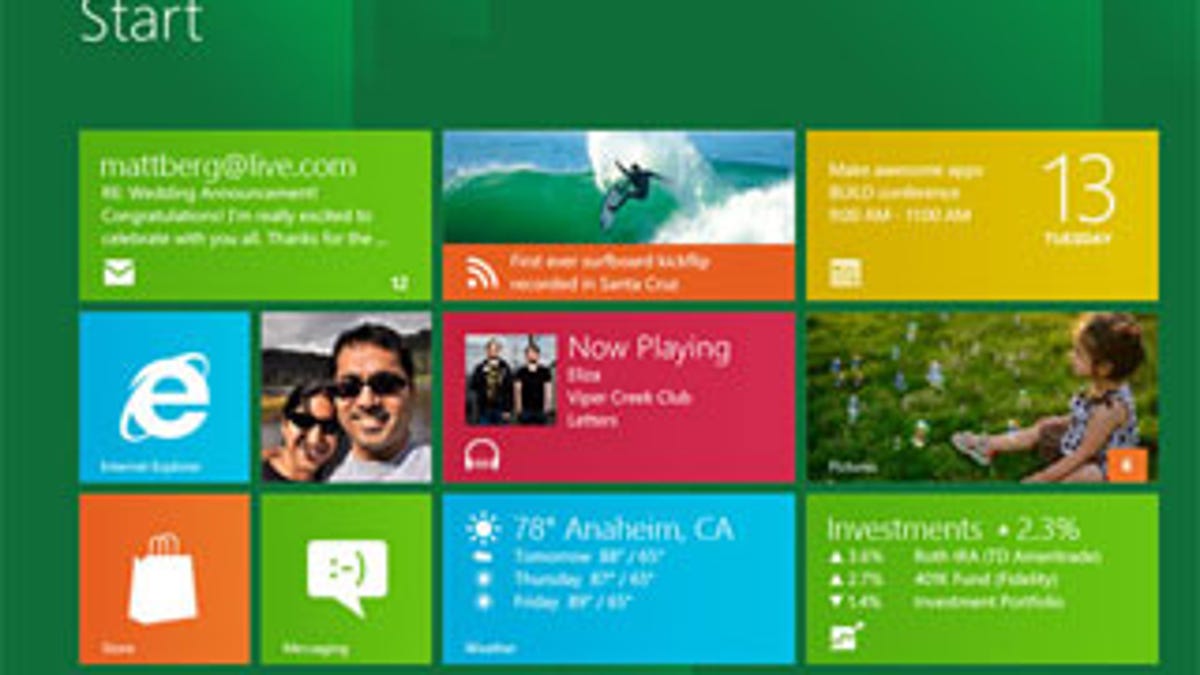Will Windows 8 Take the Touchscreen PC Mainstream?
You probably don't own a touch-enabled PC. But if Microsoft has its way, you will.

An awful lot of things have changed about PCs over the past few decades. One that hasn't has been the way we input information into them. We still use the QWERTY keyboard, which was invented by typewriter pioneer Christopher Shoales in 1873 and has been a part of the PC nearly as long as there have been PCs. And we use the mouse, invented by Douglas Engelbart in 1963 and popularized by the first Macintosh in 1984.
Other form of input include interesting technologies that have never become huge hits, such as voice input, and ones which essentially amount to mouse alternatives, including touchpads and trackballs. But nothing has really changed everything about PC input since the mouse went mainstream back in the first Reagan administration.
Windows 8, which Microsoft unveiled last week at its BUILD conference in Anaheim, is notable for many reasons. But the single most striking thing about the upgrade--which won't show up in shipping form until well into 2012--is its all-new Metro interface. As Microsoft says, Metro is "touch first." You can use it with a keyboard and mouse, but any Windows 8 PC that doesn't have a touchscreen is going to feel a tad retro. Microsoft is clearly looking towards the day when touch is as standard a PC feature as sound and a Webcam are today.
Of course, the fact that Microsoft is bullish on touch doesn't guarantee anything. When the company introduced its Tablet PC platform a decade ago--which used a stylus as a primary means of input--Bill Gates famously predicted it would be the dominant form of portable computer within half a decade. Real people, however, never warmed to the idea. But touch, which has only been part of specialty PCs such as HP's TouchSmarts until now, is going to get a shot at the big time.
Back in the 1980s, the mouse was a controversial oddity: I still remember the first time I tried to use one, and how unwieldy it seemed until I got the knack. Touch should be different, because it's already exceedingly familiar on iPhones, iPads, Android phones, and other gadgets which I insist on thinking of as new types of PCs rather than post-PC devices. Windows 8's Metro interface is no iOs or Android knockoff, but if you understand how to use a touch tablet or phone, you won't be flummoxed by a touch-first PC. (In fact, like me, you might already occasionally forget that PCs don't have touchscreens already--I've been known to poke at my display expecting it to react.)
Except it's not quite that simple. iOS and Android were built for touch from the ground up. The PC has 35 years' worth of history to deal with, starting with the fact that it's not really clear whether most people are going to find touching the vertically-oriented screen of an otherwise conventional laptop or desktop PC to be all that comfy an experience. (One person who thinks it's a bad idea is Steve Jobs, who has said it's "ergonomically terrible" and that Apple has no interest in building touch-screen Macs.)
Slapping a touchscreen on a pre-existing PC design won't work anywhere near as well as re-engineering the whole machine to make touch work well. HP, for instance, has put some of its newest TouchSmarts in cases that you can push back to a 60-degree angle that's more conducive to touch input.
Then there are all those pre-existing, non-Metro Windows apps--thousands and thousands of programs that weren't designed with touch in mind. Microsoft says that Windows 8 rejiggers the classic Windows desktop interface to work better with touch, but it's still not a pretty situation. Icons and menus are so small that you've got to learn to touch them with far more precision than Metro demands, and there's no touch-enabled counterpart to the concept of right-clicking a mouse. Until Metro apps are plentiful, touch is going to complement the mouse and keyboard rather than replace them.
(The Samsung tablet that Microsoft doled out to BUILD attendees comes with a stylus that's not really necessary for Metro programs, but which makes all the difference for conventional Windows programs. I know I already said that the world had rejected stylus-driven PCs, but maybe it'll give the idea a second chance once Windows 8 is available.)
Metro and touch input are what make the notion of an iPad-like device running Windows plausible. But will touch have a huge impact on more conventional PCs--ones with more resemblance to a desktop or laptop than to Apple's tablet? I think it will, but it may be a long, hard slog. So don't try to render a final verdict on touch now, or even when Windows 8 is ready to ship in 2012. Let's see how long it takes for really good touch-ready PCs to hit the market, and for every popular category of Windows application to make the transition to Metro.
If the process takes years, that's okay. Windows 1.0 introduced the mouse to the PC market in 1985, but it wasn't until Windows 3.0 and Windows 3.1 became rousing successes in the early 1990s that mice truly became standard equipment on Microsoft-powered PCs. If touch comes to be an utterly typical feature on new PCs by 2015 or so, it'll have ramped up faster than the mouse did. And if Apple changes its stance and introduces touchscreen Macs, that will be the surest sign of all that the technology is here to stay.

